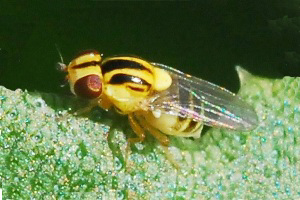Affects of Frit fly on cereal crops

By far the most important pest of newly sown perennial is the frit fly. Damage usually appears as patches of seedlings within the sward emerging poorly and growing only slowly. Affected seedlings often appear weak or stunted. The larvae which cause the damage can be seen by the naked eye, but only after careful laboratory dissection of a sample of tillers.
Grass seedlings are at their most attractive to egg-laying females when they have 2-3 leaves. Unfortunately for farmers, in autumn, seedlings often reach this stage at about the time the frit adult population reaches its peak
There are three generations of frit fly each year. Adults of the third generation are on the wing in August/September and it is larvae arising from eggs laid by them that cause the damage, eggs are laid on the underside of the leaf sheaths at the base of plant leaves and maggots rapidly hatch out to tunnel into the centre of the plant shoots to start feeding. This feeding activity on the developing tillers results in the characteristic `deadheart` symptoms. Dow AgroSciences in collaboration with IGER have produced a risk assessment chart that gives clear guidelines on when to use chlorpyrifos.
In late summer Frit fly maggots can move from a grass crop which is cultivated and ploughed in the autumn, into a following crop of grass or winter cereals. The maggots are able to survive in the decaying plant debris and can migrate to feed on the newly sown crop.
Spring sowings are seldom if ever affected but sowings made in autumn are usually damaged to some extent. There is a major risk to swards sown in mid-late August. Direct drilling almost always leads to significant damage by frit larvae (even in spring sowings) which migrate easily from the old desiccated sward to a reseed.
Establishing crops can be at risk if more than 10% of plants are attacked at the one to two leaf stage.
The new generation of insecticide seed treatments can give effective and reliable protection against frit fly damage. Successful control can also be achieved by applying contact acting insecticides at the first signs of damage.
Lengthening the interval between ploughing grass in the autumn, by a period of more than six weeks, before sowing a susceptible crop can help to prevent the maggots from moving from the decaying turf into the establishing crop.








